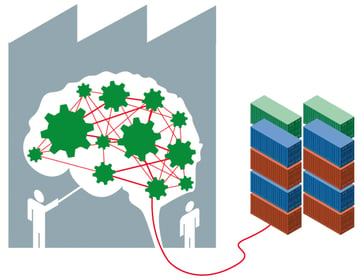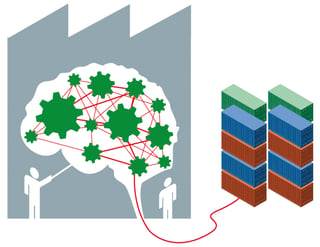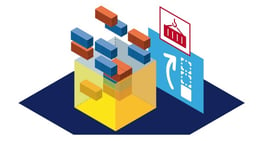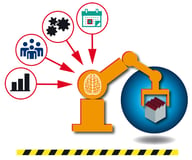How Intelligent Planning Impacts Manufacturing Efficiency
Nick Ostdick - December 21, 2017

 Intelligent production programs begin well before materials hit the production room floor. Even with an optimized production sequence with the latest in production technology platforms, today’s manufacturing companies cannot fully realize an efficient manufacturing cycle without a transparent, agile intelligent planning architecture.
Intelligent production programs begin well before materials hit the production room floor. Even with an optimized production sequence with the latest in production technology platforms, today’s manufacturing companies cannot fully realize an efficient manufacturing cycle without a transparent, agile intelligent planning architecture.
Yet even with all we know about integrated and intelligent planning systems, so many manufacturing companies still rely on ledgers, spreadsheets, or the know-how of veteran supply chain planners and managers to ensure the fluidity of product delivery and warehouse management. But in an increasingly integrated manufacturing landscape where companies are fully embracing digitization at a rate never before seen, how do companies engage in an intelligent planning process while still working in an Excel planning model? Or, and perhaps just as problematic, how do manufacturing companies combat the potential for breakdowns or bottlenecks without leveraging an intelligent planning platform?
Both of these questions are pretty damning for a modern manufacturing organization, especially those in variant-rich industries with expansive partner networks. But the good news is companies who embrace and deploy an intelligent planning strategy and solution can not only experience an increase in their manufacturing efficiencies, but they can also better position themselves in a competitive manufacturing landscape.
Trend analysis and reporting
Manufacturing companies ramp down production as the end of the year approaches, which makes it a good time to evaluate the year’s supply chain efficiency and identify problem areas or concerns. Isolating spikes and dips in warehouse holdings, transportation volumes, and container inventory are key to implementing a planning strategy for the upcoming year, and intelligent planning software allows planners to conduct in-depth reviews and generate simple, integrated reporting to increase supply chain transparency and reduce overall costs. In addition, trend analysis capabilities provide suppliers the ability to coordinate their planning efforts with different segments of the company – transportation, warehouse, and container management – and help create more seamless and consistent workflows.
But trend analysis capabilities can extend beyond the confines of traditional supply chain logistics to include a number of external factors that impact the supply stream. These analytics can offer manufacturers and suppliers great insight into industry-wide buying trends, which will help streamline all points of the supply stream.
For example, a recent report by Reuters indicated the current global decline in gasoline and oil prices sparked a significant increase in automotive sales last December throughout much of North America. The ability to monitor this trend and produce predictive models on future fluctuations in the demand for trucks and other industrial vehicles can be crucial to manufacturers and suppliers ensuring enough product to successfully and promptly fill orders and ensure on-time delivery.
Referencing past demand and performance
The ability to identify recent trends is crucial in creating efficient forecasting models, but a supply chain planner or manager's capacity to reference past demand for specific parts during specific windows of time is equally as important in ensuring supply flexibility and efficiency. Product shortages or overages are quickly becoming less and less palatable for customers in today’s marketplace, and the margin for error relative to late deliveries and errors in product quantity is becoming slimmer and slimmer. Repeat instances of either can result in severe losses in productivity, revenue, and growth. The ability to reference past demand for products is essential in ensuring these products ship and are delivered on-time and in the correct quantities.
Integrated planning software also helps increase the visibility and transparency for past demand across an entire company, allowing for a more collaborative, coordinated effort in creating consistent, synchronized planning. The more individuals with access to a company’s past demand data, the more capable that company will be in creating accurate and efficient forecasting.
Forecasting capabilities
It would stand to reason one of the most valuable features of an automated planning solution is the capacity to generate comprehensive forecasting models for planners to help gauge demand spikes and dips in the coming weeks and months.
Let’s say Company A’s supply chain team is creating a supply chain plan without the use of an intelligent planning solution. The team may be able to analyze a year or two of data to help identify trends or the nature of past demand, but with such a small sample size of data it's extremely difficult – nearly impossible – to generate any kind of accurate forecasting. The pool of data is too limited to draw from and at the end of the day will not only handcuff planners and managers in predicting to the best of their ability what’s on the horizon, but it will also have ripple effects throughout a company’s sales and operations planning (S&OP) team.
Forecasting capabilities via intelligent planning software can also be useful in establishing sales and supply chain benchmarks to help promote and encourage a company’s organic growth. Establishing such benchmarks and creating an accurate prediction of supply and sales over an upcoming span of time better equips a company to determine how and where to best allocate sales, shipping, container and warehouse resources to eliminate waste and increase communication across a variety of positions.
Simulations and what-if scenarios
It’s something you hear quite often from supply chain planners: “If only I had known then what I know now.” Whether they’re referring to late deliveries, misallocation of products, or unforeseen dips or spikes in demand for parts, planners working without an intelligent planning system are often relegated to the ‘Could have, would have, should have' result when it comes to supply chain snafus or miscalculations.
Let’s say Company A is concerned about the potential of a port strike and the ramifications in delivering products to customers on-time and in the correct quantities. Through an intelligent planning system, supply chain planners can input such an occurrence into a simulation, incorporating the accompanying variables, to help identify, analyze, and solve supply chain delays or breakdowns.
The ability to run simultaneous simulations for a variety of potential supply chain bottlenecks is a value-added proposition for any supply chain planner or manager looking for methods of increasing visibility and transparency across a variety of platforms, while at the same time reducing costs and increasing communication and collaboration company-wide.
LATEST POSTS
- Understand Circular Economy in The Manufacturing Industry
- How Can Industry 4.0 IT Integration Be Achieved Smoothly?
- The Significance of Order Sequencing in Discrete Manufacturing
- How to improve your Supply Chain Management: The Power of Control Towers
- Optimizing Human Resource Scheduling in Manufacturing: A Technological Approach



